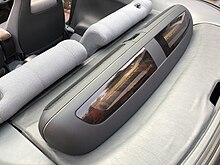
The Toyota Celica is an automobile produced by Toyota from 1970 until 2006. The Celica name derives from the Latin word coelica meaning heavenly or celestial. In Japan, the Celica was exclusive to the Toyota Corolla Store dealer chain. Produced across seven generations, the Celica was powered by various four-cylinder engines, and bodystyles included convertibles, liftbacks, coupés and notchback coupés.

The Toyota Matrix, officially named Toyota Corolla Matrix, is a compact hatchback manufactured by Toyota Motor Manufacturing Canada in Cambridge, Ontario and derived from the Corolla. Introduced in 2002 as a 2003 model, the Matrix was the result of a joint venture between Toyota and General Motors, with the GM version being the Pontiac Vibe, which was assembled by New United Motor Manufacturing, Inc. (NUMMI) in Fremont, California, United States.

The AE86 series of the Toyota Corolla Levin and Toyota Sprinter Trueno are small, front-engine/rear-wheel-drive models within the front-engine/front-wheel-drive fifth generation Corolla (E80) range—marketed by Toyota from 1983 to 1987 in coupé and liftback configurations.

The Buick Skyhawk is an automobile produced by Buick in two generations for the 1975 through 1989 model years.
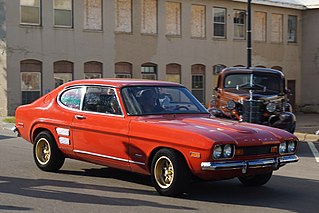
Capri is a nameplate marketed by the Lincoln-Mercury division of Ford Motor Company over three generations between 1970 and 1994.
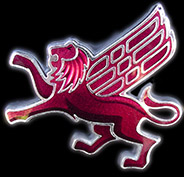
The Toyota Soarer is a personal luxury GT coupé produced from 1981 to 2005 by Toyota and sold in Japan. It was available at both Japanese Toyota dealerships called Toyota Store and Toyopet Store, and it debuted with the Z10 series, replacing the Toyopet Store exclusive Mark II coupé, the Toyota Auto Store exclusive Chaser coupé, and both the Toyota Store exclusive Crown coupé and Carina coupé.

The Nissan Prairie is an automobile manufactured and marketed by Nissan from 1981 to 2004. Considered a mini MPV or a compact MPV. It was also marketed as the Multi in Canada and the Stanza Wagon in the United States. In Japan, it was exclusive to Nissan Bluebird Store locations, then later at Nissan Blue Stage sales channels. The Prairie had a very flexible seating capability and sliding rear doors on both sides of the vehicle, with a liftgate in the back. The name "prairie" was derived from French which means an extensive area of relatively flat grassland, similar to "steppe" or "savanna".

The Toyota Previa, also known as the Toyota Estima in Japan, and Toyota Tarago in Australia, is a minivan that was produced by Toyota from 1990 until October 2019 across three generations.

The Toyota Kijang is a series of pickup trucks, station wagons and light commercial vehicles produced and marketed mainly in Southeast Asia, Taiwan, India and South Africa by Toyota between 1976 and 2007 under various other names.
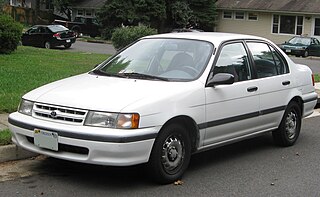
The Toyota Tercel is a subcompact car manufactured by Toyota from 1978 until 1999 across five generations, in five body configurations sized between the Corolla and the Starlet. Manufactured at the Takaoka plant in Toyota City, Japan, and sharing its platform with the Cynos and the Starlet, the Tercel was marketed variously as the Toyota Corolla II — sold at Toyota Japanese dealerships called Toyota Corolla Stores — and was replaced by the Platz in 1999. It was also known as the Toyota Corsa and sold at Toyopet Store locations. Starting with the second generation, the Tercel dealership network was changed to Vista Store, as its badge engineered sibling, the Corolla II, was exclusive to Corolla Store locations.

The Toyota Belta, referred to in North American and Australian markets as the Yaris and in Asian markets as the Vios, is a subcompact sedan manufactured by Toyota.
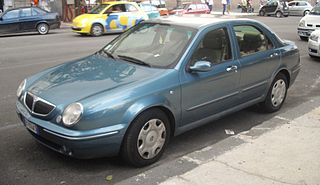
The Lancia Lybra is a compact executive car manufactured and marketed by Fiat's premium division, Lancia between 1998 and 2005, based on the Alfa Romeo 156 floorpan, and replacing the Dedra in Lancia's range. Like the Dedra, the Lybra was available as a Berlina (saloon) or a Station Wagon (estate). A total of 164,660 were made.

The Renault Mégane Renault Sport is a series of high-performance hatchback models based on the Renault Mégane, produced since 2004 by the high-performance subsidiary company Renault Sport for its parent company Alpine, a subsidiary of Renault. The Mégane RS won awards such as "Best hot hatch" from What car? (2010–2014), "Highest placed non-supercar" in Evo's annual Car of the Year test 2011 and "Best hot hatch" from Top Gear.
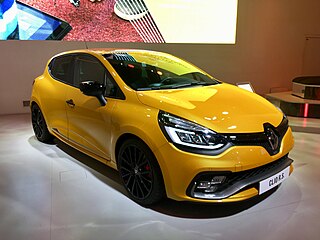
The Clio Renault Sport is a hot hatch produced by Renault Sport since 1998, the high-performance division of French automaker, Renault. It is based on the Clio supermini.

The Toyota Auris is a compact car derived from the Corolla, manufactured and sold by Toyota. Introduced in 2006, the first generation three/five-door hatchback shared the platform with the E150 series Corolla, while the second generation five-door hatchback and station wagon called "Touring Sports" uses the E180 platform. The "Auris" name is based on the Latin word for "gold", "aurum".

The sixth-generation Honda Civic is an automobile produced by Honda from 1995 until 2000. It was introduced in 1995 with 3-door hatchback, 4-door sedan and 2-door coupe body styles, replicating its predecessor's lineup. The sixth-generation Civic offered two new 1.6-liter 4-cylinder engines and a new continuously variable transmission (CVT) on the HX model. The coupe and sedan are 2.3 in (58 mm) longer and the hatchback is 4.3 in (109 mm) longer than the previous-generation Civic. This was the last generation of Civic to have front double-wishbone suspension, as the succeeding seventh generation would change the front suspension to a MacPherson strut.

The Honda Vigor is a premium sedan that was derived from the Honda Accord. It was sold in Japan through the Honda Verno dealer network from 1981 until 1995, and sold in North America from June 1991 until 1994 as the Acura Vigor. Early Vigors were more upmarket versions of the Accord, and served as Honda's flagship until the arrival of the Honda Legend. In 1989, the Vigor would differentiate itself further from the Accord with unique styling and an available longitudinal five-cylinder engine, and a twin to the Vigor was introduced with the Honda Inspire, available at Honda Clio dealerships.
Toyota Concept Vehicles produced between 1980 and 1989 include:

The Toyota 86 and the Subaru BRZ are 2+2 sports cars jointly developed by Toyota and Subaru, manufactured at Subaru's Gunma assembly plant.

The Ford Mondeo I (first generation) is a mid-size car that was produced by Ford, beginning on 23 November 1992, with sales beginning on 22 March 1993. It is also known as the Mk I Mondeo; the 1996 facelift versions are usually designated Mk II. Available as a four-door saloon, a five-door hatchback, and a five-door estate, all models for the European market were produced at Ford's plant in the Belgian city of Genk. In December 1992, Autocar published a section on the Mondeo, and how it would conquer rivals.





